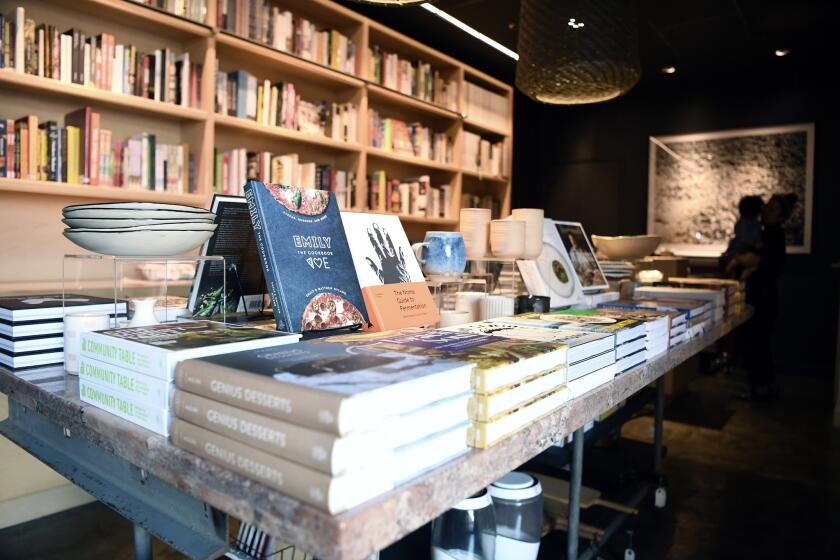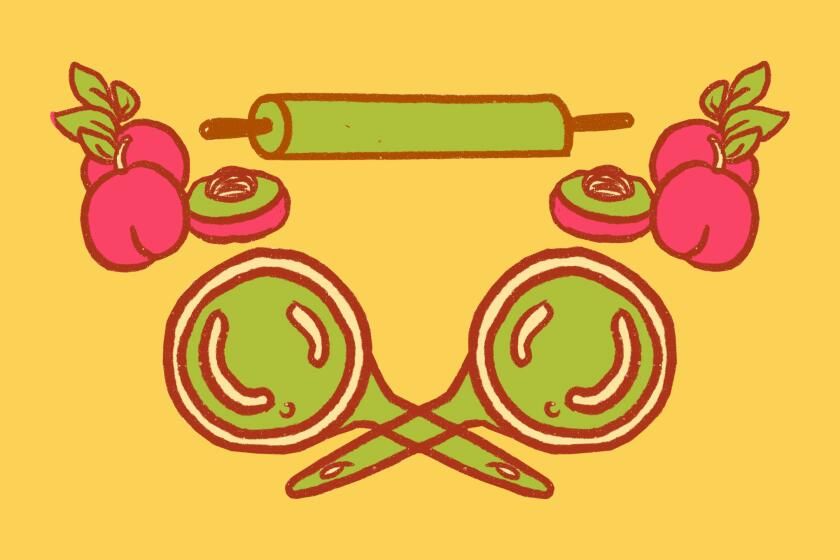Column: When it comes to restaurants, whose dish is it anyway?

- Share via
This summer may have been the first time we’ve seen mold go viral. One of the latest in the food world’s series of highly publicized reckonings comes by way of Virgil Avenue in East Hollywood, and a small jam commissary that opened in 2011 and quickly rocketed to popularity. Sqirl’s chef-owner, Jessica Koslow, faced allegations that jams — a restaurant signature — were improperly stored and that contaminated jam might have been served to customers, as emblemized in one particularly unsavory-looking bucket of moldy preserves that made its way around the internet.
But, like a bucket of moldy jam, the situation at Sqirl becomes more interesting when you scrape off the top layer:
The health and safety allegations were part of a larger conversation as former Sqirl employees began to speak out about their work experiences in blunt, emotional testimonies. They said the restaurant had an illegal kitchen space, hidden from health inspectors, and a vermin problem. Employees also said that people who were cooking at the restaurant were not given credit for creating and executing some of Sqirl’s signature dishes.
While mold and its potential health hazards shouldn’t be minimized, fixing those issues would seem fairly straightforward. Koslow posted statements on Twitter and Instagram, outlining her pasteurizing and canning process for jams sold at retail and acknowledged that “there were occasional instances where mold would develop” on jam served in the restaurant but that it was removed before serving. “To guide this practice,” she wrote, “I relied on the research and guidance of health experts and to my knowledge thought it was safe.”
Koslow apologized and said she would implement a pasteurized “hot pack” method — used for her retail products — for all jam used in the restaurant. She also said that Sqirl “does not and has not had a rat problem” and addressed allegations of a “secondary kitchen,” acknowledging the space “fell off the radar of the Health Department, despite the fact that Sqirl’s main kitchen received regular inspections.”
Issues of credit are trickier, and more subjective — for all restaurants.
In traditional kitchens, it’s long been accepted practice that whatever chefs or cooks create while in the employment of a restaurant belongs to the restaurant and its chef. Even in the case of a chef who may not always be present at the restaurant — or who, frankly, may not even actively cook much anymore.
But back-of-house employees have started to challenge that.
“Even though she assumed the title [of chef], a lot of the dishes that were the spark of Sqirl — the specials, the seasonal rotating dishes — she did not create,” said former Sqirl chef Ria Dolly Barbosa, one of four former Sqirl employees with whom I spoke.
Barbosa said many of Sqirl’s dishes — including the signature ricotta toast, jam-stuffed French toast and sunchoke hash — were made without significant input from Koslow. She also said that other well-known Sqirl dishes, such as the crispy rice salad and sorrel pesto rice bowl, were collaborative to a degree, but that Koslow lacked the ability to independently create or execute those dishes on her own.

A spokesperson for Koslow says the creation of these dishes was a collaborative process and disputes the suggestion that Koslow played no role. “Jessica wanted an adaptation of a blintz on the menu,” the spokesperson said. “Matt [Wilson] (sous chef) made the original ricotta recipe (which has since changed and evolved). Victor (a former line cook) later added the rainbow of jams. The ricotta toast dish, as a whole, was a collaborative creation by a collaborative team.”
In terms of the jam-stuffed French toast, the spokesperson said, “Ria Barbosa did develop and perfect the jam-stuffed brioche French toast for Sqirl, and Jessica has never claimed otherwise. That dish highlighted Jessica’s jam and the dish as a whole was in fact Ria’s adaptation” of a pain perdu from a previous employer.
It isn’t possible to copyright recipes. So how do you decide who gets credit for them?
Javier Ramos, another former Sqirl chef, said Koslow “could not offer any leadership or mentorship or cooking techniques” but “would happily accept the accolades,” which included three consecutive James Beard Foundation Award nominations. (A finalist for this year’s awards, Koslow withdrew her name from consideration. Last month the James Beard Foundation announced it would not name any more winners for 2020 awards and that awards will not be presented in 2021.)
“I have never claimed to be the creator and sole perfecter of Sqirl’s recipes,” Koslow said in an email. “The truth is far more complicated and nuanced. Many recipes are original creations of our incredible cast of Chefs De Cuisine, Sous Chefs, and Pastry Chefs, (and me), while others are collaborations or iterations of another idea or inspiration. These individuals, in addition to the front-line, front of the house staff who make Sqirl a pleasant place to gather, are the bedrock of our success and why it has resonated with people.
“There is an existing structure in our industry for how restaurants retain the creative recipes and techniques that many chefs contribute to the place during their employment and we have made changes to the way we credit recipes,” Koslow continued. “I am profoundly grateful for their creations and talent and love that go into Sqirl’s menu and I have apologized for and have worked to fix my own mistakes, but I am not in a position, standing alone, to apologize for a business structure that is foundational to the entire service industry and the majority of American businesses.”
I’ve never watched Koslow cook and I’m not a chef; it’s not up to me to judge skill or acumen. And is there a whiff of misogyny in some of the social media chatter? Few male chefs, some of whom are accused of far worse than scraping mold off of jam buckets, have had the microscope turned on them in even a fraction of the way Koslow has over the past months.
Regardless, it’s essential that we listen to kitchen staff who are often muted in a media landscape obsessed with star power. The controversy at Sqirl speaks to many of the larger issues currently roiling the restaurant industry: an owner’s responsibility to employees and surrounding neighborhood; what the word “chef” means in the context of an evolving industry; and the role of media in fostering celebrity culture in the restaurant world. In particular, conflicts over giving and receiving credit for recipes in an industry where back-of-house staff are often unnoticed have been laid bare.
***
Much of the conflict over credit comes down to the word “chef.” What your chef says, goes. Often rising through the ranks of kitchens themselves, they’re looked up to and respected by younger cooks.
“You would never disrespect your chef,” said Meadow Ramsey, Sqirl’s former pastry chef, referring to the traditional brigade system. “You were always trying to get things done perfectly and quickly and get their approval.”
(Established more than 100 years ago by Auguste Escoffier, the brigade system is based, quite literally, on a militaristic hierarchy. At the top of the heap is your chef de cuisine, or possibly an executive chef, followed by sous and pastry chefs, line cooks, prep cooks, on down the line. There are expectations for those making the cold dishes, pastas or working the fryer and, depending on the kitchen, there’s a fairly rigid pecking order.)
Chad Colby, who opened Antico with partner Kevin Caravelli last year, said he had created dishes at other restaurants where he’d worked with the understanding that he wouldn’t be specifically credited. “I don’t really know what precedent there is to acknowledge every person’s contribution to every single dish,” he said. Often, just having something make the menu was payment enough. “It’s definitely a reward, from your peers and employers.”
(One of the big draws at Antico is the ice cream; Colby is forthcoming about the fact that the recipes come from Brad Ray, the pastry chef and executive sous chef at the restaurant. “I always give him credit that he developed everything.”)
Of Koslow, Colby said, “I think she curated it [Sqirl] to her aesthetic, and in some ways that’s more important than all the chef skills.” He also added that fully crediting and acknowledging contributions “is the high road. It’s the better thing to do.”
“It probably wouldn’t have taken a lot to defuse that situation,” Colby said of Sqirl’s controversies.
At some restaurants, the notion that your creations might be claimed by the chef is not merely accepted but an honor. But with pay that hovers around minimum wage for starting cooks, long hours and physically demanding conditions, why would anyone subject themselves to that?

Exchange of knowledge.
Pastry chef Roxana Jullapat of Friends & Family worked at Campanile under Nancy Silverton as a young cook. “I was being mentored and trained at such a high level in such an extraordinary place,” Jullapat said. “I was like, ‘Thank you for letting me make you a cookie!’
“If a restaurant is giving you an opportunity to shop for amazing fruit, test ideas you have in your head or talk about it to a mentor, or even your co-workers, to put it on a menu and have customers taste it and like it or not — I feel like that is the reward,” she said.
Existing cracks in the restaurant system, further exacerbated by COVID-19, have left chefs looking for solutions. One restaurant group in South Carolina, City Grit, is experimenting with a nontraditional model.
Trevor Kunk, who worked for seven years as chef de cuisine at Blue Hill at Stone Barns in New York, said that in such a tight-margined industry, it may not be possible to pay young cooks very much — but that that can be made up for, at least in part, by education. “If you’re going to have to pay them minimum wage, you have to make sure they’re not just learning one thing,” he said, but rather “learning five things every day that they can put in their notebook and take with them.”
That value exchange is what propels future generations of chefs — and incentivizes young cooks to grind it out during the lean early years. “You mentor people so they can go and spread their wings elsewhere,” said Ramos. “That’s how you build a team.”
That knowledge exchange is what propels future generations of chefs — and incentivizes young cooks to grind it out. “You mentor people so they can go and spread their wings elsewhere,” said Ramos. “That’s how you build a team.”
Jullapat, who said she’s eaten at Sqirl “countless” times, tried to capture the complexity of how a business owner and her staff could have two wildly different points of view on history. “I believe everyone,” she said. “But I also believe Jessica when she says she has a genuine appreciation for her staff.”
***
There may be no other business where a team effort is more essential than in the restaurant industry. But you wouldn’t know it from media coverage, much of which pushes a chef-as-auteur narrative, crediting a single person for a restaurant’s output or glossing over key players.
Consider: In February 2014, the website StarChefs, an industry organization that highlights young talent in the restaurant world, published a photo feature with the headline, “Chef Jessica Koslow and Pastry Chef Meadow Ramsey of Sqirl.”
Barbosa, who says she conceived of at least one of the dishes featured, a stone crab stuffed with brown rice, was not credited, despite the fact that she was Sqirl’s chef de cuisine at the time. There’s even a stand-alone shot of her in the photo gallery. (StarChefs did not respond to a request for comment.)
“I think I ran to my car and cried,” Barbosa said. “I did that quite a few times. I felt hidden and pushed away, essentially.”
“That particular recipe was inspired by Ria’s great dish and later modified by Patch Troffer,” Koslow said in an email. “At all phases of its life, it was a Sqirl dish, made for the restaurant.”
(A representative for Koslow says she suggested to StarChefs in a 2016 email that Ramos could be nominated to its newest class of “rising stars.” In another email, sent in January, Koslow sent the names of six employees — who worked at Sqirl or Onda in Santa Monica — in response to a call for nominations for “rising stars.” Koslow’s representative also offered a long list of “staff credited in media” and social media, including The Times, Los Angeles magazine, the New York Times, L.A. Weekly and Instagram.)
Probably every food writer who’s been at it for a while has written an adulatory chef profile, including me. We do it because it’s appealing and, frankly, out of laziness: It’s easier than capturing a more complete picture.
The Times has written about many prominent chefs over the years — Michael Cimarusti, Josef Centeno, Jeremy Fox — without training the lens on their back-of-house staff.
The New York Times praised Koslow as a “genius” in a 2019 feature. Bloomberg wrote about “jam that changed my life.” A Who What Where article lauded her as “completely self-taught” and “revolutionary.” Last year, the L.A. Times put Sqirl at No. 16 on its 101 Best Restaurants list, and critic Jonathan Gold spoke of how Koslow “captures the flavor of a season and a place in a jar” with her jams.
But media buildups can quickly give way to teardowns. In the week after Sqirl’s mold problems became public, the glee over the controversy was almost palpable in stories from Vice, LAist and others. Eater, which has published many glowing articles on Sqirl and Koslow, including a photo essay on its ricotta toast, published no fewer than six pieces addressing the controversy.
Nor am I guiltless: I posted a silly joke on Twitter riffing on the band name Pearl Jam — it sounds a lot like “Sqirl Jam” — which certainly could be interpreted as having a laugh at the restaurant’s expense.

Restaurants and their hard-working staffs deserve more.
In a piece in the New Republic in July, Kate Telfeyan addresses the responsibility of media in creating a cult of personality around chefs — one that can insulate them for years against criticism. Telfeyan, who has worked in restaurant PR and as a chef, spoke of the need to hear more from prep cooks, dishwashers and food runners — the people who actually run a restaurant on a day-to-day basis.
“This isn’t simply a question of covering abuse and manipulation in kitchens, or mistreatment of employees,” Telfeyan wrote. “It’s about questioning the whole concept of kitchen creativity — asking smart questions about originality, credit and the act of culinary creation, which is far more collaborative than readers might understand.”
She’s right. It should be a goal that for every glowing chef profile that is written, at least two or three members of the front- and back-of-house staff also are interviewed independently. And if the chef is hesitant to grant access to those employees? Or those people are afraid to speak their minds? That should factor into a decision whether to run a profile.
As if the layers of this couldn’t get more complicated, there’s COVID-19. Causing an independent restaurant to lose business — any business at all, for any reason — could be seen as gravely irresponsible. During a time where millions of jobs have been lost and 85% of independent restaurants could permanently close by the end of the year, by some estimates, the slightest downtick in revenue can seriously affect livelihoods.
Soon after the jam debacle became public, I went by Sqirl to chat with some of the staff (I didn’t see Koslow there). Alex Fonseca, a floor manager, implored people to remember: Sqirl has employees. A lot of them. “Honestly, a lot of people just want to keep their jobs. And I think a lot of people feel genuinely threatened by this,” he said, referring to the negative publicity.
That might be the most important lesson of all. No matter what role we play in the restaurant ecosystem, we should all spend more time thinking about the prep cooks, the runners, the dishwashers and the servers: the people who actually make this industry go.
More to Read
Eat your way across L.A.
Get our weekly Tasting Notes newsletter for reviews, news and more.
You may occasionally receive promotional content from the Los Angeles Times.













